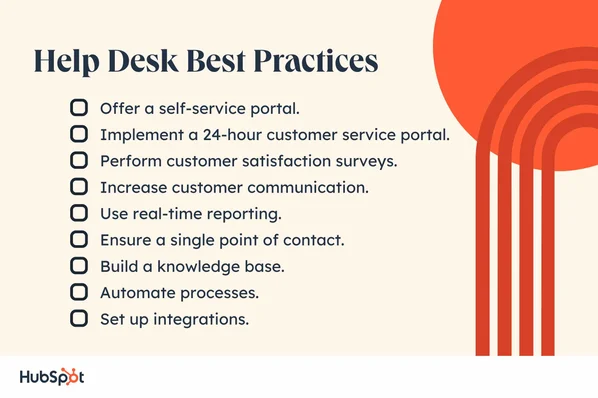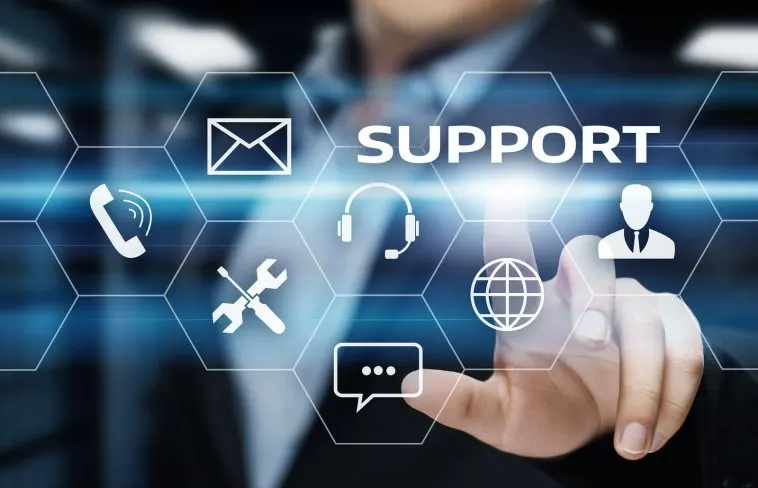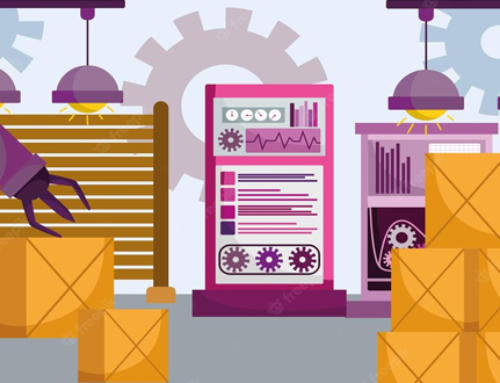Introduction to Help Desk Management: The Lifeline of Smooth Operations
In today’s technology-driven world, businesses rely heavily on efficient IT infrastructure and seamless user experiences. This is where help desks come in – they serve as the vital first point of contact for users encountering technical issues or seeking assistance. This comprehensive guide delves into the world of help desk management, exploring its definition, evolution, and the key components that make a modern help desk successful.
Definition and Importance of Help Desks
A help desk, sometimes referred to as a service desk, is a centralized system designed to address user inquiries and troubleshoot technical issues. It acts as a single point of contact for users seeking assistance with:
- Hardware or software problems
- Account access issues
- Application functionality questions
- General technical support
Importance of Help Desks:
- Increased User Productivity: Prompt resolution of user issues minimizes downtime and ensures a smooth workflow.
- Improved Customer Satisfaction: Efficient help desks resolve problems quickly and professionally, enhancing customer satisfaction.
- Proactive Problem Identification: Help desks can identify trends in user issues, enabling proactive troubleshooting and preventing future problems.
- Enhanced IT Efficiency: Centralized ticketing systems streamline issue tracking and resource allocation for IT teams.
- Data-Driven Decision Making: Help desk data provides valuable insights into user behavior and common issues, allowing for informed IT strategy development.
Evolution of Help Desk Systems
Help desks have undergone a significant transformation over the years:
- Traditional Help Desks: Early help desks relied on phone calls and in-person support, often leading to bottlenecks and long wait times.
- Email Support: The introduction of email support offered a more convenient avenue for user requests, but lacked the structure and efficiency of dedicated systems.
- Ticketing Systems: The emergence of ticketing systems provided a centralized platform for tracking and managing user issues, improving efficiency and accountability.
- Self-Service Portals: The rise of self-service portals empowers users to find solutions to common problems through knowledge bases, FAQs, and online tutorials.
- Cloud-Based Solutions: Cloud-based help desk solutions offer flexibility, scalability, and accessibility from anywhere, making them ideal for today’s mobile workforce.

Key Components of a Modern Help Desk
A modern help desk incorporates several key components to deliver an efficient and user-friendly experience:
- Ticketing System: The cornerstone of a help desk, a ticketing system allows for logging, tracking, and prioritizing user issues. It facilitates communication between users and support agents, ensuring timely resolution.
- Knowledge Base: A well-maintained knowledge base empowers users to find solutions to common problems on their own. It should be easily searchable and contain clear, concise information on frequently encountered issues and troubleshooting steps.
- Reporting and Analytics: Robust reporting tools provide valuable insights into user behavior, common issues, and agent performance. These data analytics enable data-driven decision making and continuous improvement of the help desk’s efficiency.
- ITIL Framework: The IT Infrastructure Library (ITIL) framework offers a set of best practices for IT service management, including incident management, problem management, and change management. Adopting elements of ITIL can further enhance a help desk’s effectiveness and structure.
Integration with Other Systems: Integration with other business systems, like CRM or HR software, streamlines user data management and provides a holistic view of user needs.
Help desks are crucial for any organization that relies on technology. Understanding their definition, importance, and core components empowers businesses to create a robust and efficient system that ensures user satisfaction and optimizes IT operations. As we delve deeper into this guide, we’ll explore the various aspects of help desk management, equipping you with the knowledge and strategies to establish a thriving help desk within your organization.
Choosing the Right Help Desk Software: Equipping Your Team for Success
A well-chosen help desk software forms the backbone of efficient user support. This section equips you with the knowledge to navigate the selection process and identify the solution that best aligns with your organization’s needs.

Evaluating Business Needs
Before diving into software options, take a step back to clearly define your specific requirements:
- User Base Size: Consider the size and complexity of your user base. Needs of a small team will differ from those of a large enterprise.
- Support Channels: Identify the communication channels you want to offer (phone, email, chat, self-service portal) and ensure the software supports them.
- Budget: Determine your budget constraints and prioritize features that deliver the most value for your investment.
- Scalability: Consider your organization’s growth plans. Choose software that can scale to accommodate a growing user base and future needs.
- Security: Data security is paramount. Ensure the software offers robust security features to protect user information and sensitive data.
Features to Look for in Help Desk Software
Here are key functionalities to consider when evaluating help desk software:
- Ticketing System:
- Efficient ticket creation, assignment, and tracking capabilities are essential.
- Features like priority levels, status updates, and internal notes ensure streamlined communication and issue resolution.
- Knowledge Base Management:
- Users should be able to easily search for solutions through a comprehensive and user-friendly knowledge base.
- The software should facilitate knowledge base creation, editing, and version control to ensure information accuracy.
- Automation:
- Automate repetitive tasks like sending notification emails or resetting passwords to free up agent time for complex issues.
- Look for features like auto-tagging (categorizing tickets based on keywords) and predefined workflows for efficient issue resolution.
- Reporting and Analytics:
- Generate reports to gain insights into user behavior, identify common issues, and track agent performance.
- Utilize these insights to improve the help desk’s efficiency and effectiveness.
- Additional Features:
Consider features like self-service portal customization, integration with other business systems (CRM, HR), mobile app availability, and community forums for peer-to-peer support.
Comparing Popular Help Desk Solutions
The help desk software market offers a diverse range of solutions. Here’s a brief overview of some popular options to get you started:
- Cloud-Based Solutions: Offer subscription-based pricing, scalability, and accessibility from anywhere. Popular options include:
- Zendesk: User-friendly interface, robust ticketing system, and strong customer support.
- Freshdesk: Affordable option with a wide range of features, including self-service portal and mobile app.
- ServiceNow: Enterprise-grade solution with powerful features and customization options, but may require a larger budget.
- On-Premise Options: Require installing software on your own servers, offering more control over data security but also higher upfront costs. Popular options include:
- osTicket: Open-source and free to use, but requires technical expertise for setup and maintenance.
- Spiceworks Help Desk: Free option with basic ticketing functionalities, ideal for small businesses.
Choosing the Right Fit:
There’s no one-size-fits-all solution. Carefully evaluate your needs, compare features offered by different vendors, and consider factors like budget, user base size, and desired level of customization.
Free Trials and Vendor Demos:
Many vendors offer free trials or demo versions. Take advantage of these opportunities to test-drive the software and assess if it meets your specific requirements and user experience expectations
Conclusion:
Selecting the right help desk software is a crucial step in establishing an efficient and user-friendly support system. By thoroughly evaluating your needs and exploring the features offered by various vendors, you can equip your team with the tools they need to deliver exceptional customer service and ensure the smooth operation of your IT infrastructure. The next section will delve into the art of implementing your chosen help desk software and establishing efficient workflows within your organization.
Setting Up an Effective Help Desk: Optimizing Workflows and User Experience
Having chosen the right help desk software, it’s time to configure it for optimal performance. This section explores key steps involved in setting up an effective help desk that prioritizes user experience and streamlines workflows for your support team.

Designing a User-Friendly Interface
A user-friendly interface is crucial for both your support agents and the users seeking assistance. Here’s how to achieve it:
- Self-Service Portal: Design a user-friendly self-service portal that empowers users to find solutions independently.
- Include a searchable knowledge base with clear and concise articles, FAQs, and troubleshooting guides.
- Offer step-by-step instructions with screenshots or videos for better understanding.
- Knowledge Base Accessibility: Ensure the knowledge base is easily accessible from both the self-service portal and the ticketing system.
- Encourage users to search for solutions before submitting tickets, reducing the burden on support agents.
- Clear Navigation: Make sure the interface is intuitive and easy to navigate for both users and support agents.
- Utilize clear labels, consistent formatting, and a logical layout to minimize confusion.
Implementing Ticketing Systems
The ticketing system is the backbone of your help desk. Here’s how to set it up for efficient issue management:
- Ticket Categories: Create clear and well-defined ticket categories to categorize incoming requests (e.g., hardware issues, software problems, account access).
- This facilitates efficient routing of tickets to the most qualified support agents.
- Customization: Custom ticket fields to capture the information needed to resolve issues efficiently.
- Consider including fields like device type, software version, error messages, and urgency level.
- Automation Rules: Utilize automation rules to streamline repetitive tasks and expedite issue resolution.
- Set up rules for auto-tagging tickets based on keywords, sending automatic notifications, or escalating unresolved tickets after a certain timeframe.
- Workflow Creation: Define workflows for different types of issues, outlining the steps support agents need to take for resolution.
- This ensures consistency and reduces the time it takes to resolve common problems.
Integrating Automation for Efficient Responses
Automation can significantly enhance the efficiency and responsiveness of your help desk:
- Canned Responses: Create pre-written responses for common user inquiries to save agents time and ensure consistent messaging.
- Personalize canned responses where appropriate to avoid a robotic tone.
- Auto-Resolution Rules: Set up rules to automatically resolve simple issues based on predefined criteria.
- This could involve resetting passwords, generating new activation codes, or providing links to relevant knowledge base articles.
- Self-Service Workflows: Design workflows within the self-service portal to guide users through troubleshooting steps or basic issue resolution processes.
- This empowers users to resolve minor issues independently, reducing the number of tickets submitted.
Additional Considerations:
- Security Configuration: Configure the help desk software to ensure data security and user privacy.
- Implement access controls, data encryption, and regular backups.
- Reporting and Analytics: Utilize the reporting functionalities of your help desk software to gain valuable insights.
- Track key metrics like ticket resolution time, agent performance, and user satisfaction.
- Use these insights to identify areas for improvement and continuously optimize your help desk operations.
Conclusion:
By carefully designing the user interface, implementing a robust ticketing system, and strategically integrating automation, you can establish an effective help desk that empowers users, streamlines workflows, and ensures the smooth operation of your IT infrastructure. The next section will focus on recruiting, training, and managing your help desk team, the heart of your user support system.
Enhancing Customer Support with Help Desk Best Practices

A well-configured help desk is only as effective as the team managing it. This section explores key best practices to empower your help desk team and elevate your customer support to new heights.
Prioritizing and Categorizing Tickets
Efficient ticket management is paramount for swift issue resolution and improved customer satisfaction. Here’s how to achieve it:
- Prioritization: Establish clear prioritization criteria based on factors like urgency, impact on business operations, and Service Level Agreements (SLAs) with users.
- SLAs define the expected timeframe for resolving different types of issues.
- Categorization: Utilize the ticket categories defined during setup (Section III.B) to ensure tickets are routed to the most qualified support agents.
- This ensures faster resolution times and leverages the expertise of your team.
- First Call Resolution (FCR): Strive for high FCR rates, resolving user issues on the first contact whenever possible.
- This minimizes frustration for users and reduces the workload on support agents.
Implementing Knowledge Base for Self-Help
A comprehensive knowledge base empowers users to find solutions independently and reduces the burden on your support team:
- Knowledge Base Maintenance: Maintain an up-to-date knowledge base with clear, concise, and well-organized information.
- Regularly review and update articles to reflect changes in software, hardware, or troubleshooting procedures.
- User Feedback: Encourage users to provide feedback on knowledge base articles.
- Use this feedback to identify areas for improvement and ensure the knowledge base remains helpful and relevant.
- Searchable Content: Utilize clear and consistent language throughout the knowledge base.
- Implement effective search functionalities to allow users to easily find the information they need.
Providing Timely and Proactive Communication
Effective communication is key to building trust and ensuring user satisfaction:
- Active Listening: Actively listen to user concerns and understand the issue thoroughly before suggesting solutions.
- Demonstrate empathy and acknowledge user frustration.
- Clear Communication: Communicate clearly and concisely using language that users can understand.
- Avoid technical jargon and explain complex issues in a simple and straightforward manner.
- Customer Service Skills: Train your support agents in customer service best practices.
- This includes fostering a positive and helpful attitude, demonstrating patience, and actively working towards resolving user issues.
- Proactive Communication: Keep users informed throughout the resolution process.
- Provide updates on the status of their ticket and estimated timelines for resolution.
Additional Best Practices:
- Invest in Agent Training: Provide ongoing training to your help desk team on new technologies, troubleshooting procedures, and best practices in customer service.
- Performance Measurement: Track key metrics like ticket resolution time, customer satisfaction scores, and agent performance.
- Use this data to identify areas for improvement and continuously enhance your help desk operations.
- Collaboration and Knowledge Sharing: Encourage collaboration among support agents.
- Foster a knowledge-sharing environment where agents can learn from each other’s experiences.
Conclusion:
By prioritizing tickets effectively, maintaining a comprehensive knowledge base, and prioritizing clear communication, you can empower your help desk team to deliver exceptional customer support. Remember, a happy and well-trained team is essential for a thriving help desk operation. The final section will explore essential metrics for measuring help desk performance and ensuring continuous improvement.
Utilizing AI and Chatbots in Help Desk Operations

The world of technology is constantly evolving, and the help desk is no exception. Artificial intelligence (AI) and chatbots are transforming the way user support is delivered, offering exciting possibilities for enhanced efficiency and improved user experience.
The Role of Artificial Intelligence
AI can be leveraged in several ways to optimize help desk operations:
- Automated Ticketing: Utilize AI to automatically categorize and prioritize incoming tickets based on keywords, urgency, and past resolution data.
- Smart Knowledge Base Search: Implement AI-powered search functionalities within the knowledge base to provide users with more relevant and helpful results.
- Predictive Analytics: Analyze historical data to identify potential issues and proactively address them before they impact users.
Integrating Chatbots for Instant Assistance
Chatbots powered by AI can provide users with immediate assistance and reduce the burden on live support agents:
- 24/7 Availability: Chatbots can answer basic questions, troubleshoot common problems, and direct users to relevant knowledge base articles around the clock.
- Faster Resolution Times: By deflecting simple inquiries, chatbots can free up agents to focus on more complex issues, leading to faster resolution times.
- Improved User Satisfaction: Offering immediate assistance through chatbots enhances user experience and demonstrates a commitment to resolving issues promptly.
Enhancing User Experience with Smart Automation
Strategic automation powered by AI can streamline workflows and personalize user interactions:
- Automated Responses: Implement AI-powered chatbots to provide users with automated responses to frequently asked questions, reducing wait times for live agents.
- Sentiment Analysis: Utilize AI to analyze user sentiment in chats and tickets, allowing agents to tailor their communication style and identify potentially frustrated users.
- Personalized Recommendations: Leverage AI to recommend relevant knowledge base articles or troubleshooting steps based on a user’s specific issue.
Conclusion:
AI and chatbots offer a glimpse into the future of help desks. By strategically integrating these technologies, you can enhance user experience, streamline workflows, and empower your team to deliver exceptional customer support. As we conclude this comprehensive guide, the next section will explore key metrics for measuring help desk performance and ensuring continuous improvement.
Measuring Help Desk Performance: Optimizing for Success

An effective help desk is data-driven. Tracking key metrics allows you to assess performance, identify areas for improvement, and demonstrate the value your help desk delivers to the organization. Here’s how to measure your help desk’s success:
Key Performance Indicators (KPIs) for Help Desk
Several key performance indicators (KPIs) provide valuable insights into help desk effectiveness:
- First Call Resolution (FCR) Rate: Measures the percentage of issues resolved on the first contact with a support agent. A high FCR rate indicates efficient problem-solving and reduces user frustration.
- Average Resolution Time (ART): Tracks the average time it takes to resolve a ticket from submission to closure. Lower ART signifies efficient issue resolution and improved user satisfaction.
- Customer Satisfaction (CSAT): Gauges user satisfaction with the help desk experience through surveys or feedback forms. High CSAT scores indicate a positive user experience and effective support.
- Agent Productivity: Measures the number of tickets resolved by an agent within a specific timeframe. While not the sole indicator, it can help identify training needs or areas for workflow improvement.
- Ticket Volume and Trends: Monitor the volume of tickets received and identify any trends. Sudden spikes could indicate emerging issues or system problems requiring attention.
Conducting Customer Satisfaction Surveys
Regularly conduct customer satisfaction surveys to gather user feedback on their experience with the help desk. This feedback is invaluable for identifying areas for improvement and ensuring your help desk aligns with user needs.
Continuous Improvement Strategies
Utilize the data gathered from KPIs and customer surveys to implement continuous improvement strategies:
- Refine Processes: Analyze bottlenecks and identify areas where processes can be streamlined to improve efficiency.
- Invest in Training: Provide ongoing training to your help desk team based on identified knowledge gaps or emerging technologies.
- Knowledge Base Optimization: Continuously update and improve your knowledge base to ensure it remains relevant and user-friendly.
- Technology Evaluation: Regularly evaluate your help desk software and explore new technologies that can further enhance your operations.
Conclusion:
By establishing a data-driven approach and focusing on continuous improvement, you can ensure your help desk operates at peak efficiency. Remember, a well-managed help desk is an invaluable asset, promoting user satisfaction, optimizing IT operations, and driving the success of your organization.
Training and Development for Help Desk Teams
An effective help desk relies on a skilled and knowledgeable team. Investing in ongoing training and development empowers your agents to deliver exceptional customer service and navigate the ever-evolving world of technology.
Importance of Ongoing Training
Technology is constantly changing, and so are user needs. Regular training ensures your team stays abreast of:
- New Technologies: Familiarize agents with new software, hardware, and troubleshooting procedures to effectively support users encountering emerging issues.
- Updated Processes: Keep your team informed about any changes in internal workflows or help desk procedures to ensure consistency and efficiency.
- Enhanced Skill Sets: Provide training opportunities to develop specific skillsets, such as advanced troubleshooting techniques or data analysis.
Developing Soft Skills for Customer Interaction
Beyond technical knowledge, strong soft skills are crucial for success:
- Communication Skills: Train agents in active listening, clear communication, and conflict resolution to foster positive interactions with users.
- Problem-Solving Skills: Equip agents with effective problem-solving strategies to analyze user issues and identify optimal solutions.
- Customer Service Skills: Develop a customer-centric approach, emphasizing empathy, patience, and a commitment to user satisfaction.
Staying Updated on Technological Advancements
The IT landscape is constantly evolving. Help desk professionals need to stay current with:
- Emerging Technologies: Educate your team on new technologies that may impact user support, such as artificial intelligence or cloud computing.
- Industry Best Practices: Keep your team updated on the latest trends and best practices in help desk management to continuously optimize operations.
By investing in training and development, you empower your help desk team to excel in their roles, provide exceptional user support, and ensure the smooth operation of your IT infrastructure.
The Future of Help Desk Technology: A Glimpse Ahead

The help desk of tomorrow is poised to be a dynamic and intelligent entity. Here’s a peek into some exciting trends shaping the future:
Trends in Help Desk Automation:
- AI-powered chatbots will become even more sophisticated, handling complex inquiries and offering personalized support.
- Machine learning algorithms will automate repetitive tasks, freeing agents to focus on strategic problem-solving.
- Predictive analytics will proactively identify potential issues, allowing for preventative measures and improved uptime.
Integration with Emerging Technologies:
- Help desks will seamlessly integrate with virtual reality (VR) and augmented reality (AR) tools, enabling remote troubleshooting and enhanced user guidance.
- The rise of the Internet of Things (IoT) will necessitate robust help desk solutions equipped to manage and support interconnected devices.
Adapting to Evolving Customer Service Expectations:
- Omnichannel support will become the norm, allowing users to seek assistance through their preferred channels (chat, social media, etc.).
- Self-service options will become more personalized, leveraging AI to recommend relevant knowledge base articles and troubleshooting steps.
- The focus will shift from reactive support to proactive user experience management, ensuring a seamless and positive user journey.
The future of help desk technology is bright, promising a more automated, intelligent, and user-centric approach to customer support. By embracing these trends, organizations can stay ahead of the curve and ensure their help desks continue to deliver exceptional service in a rapidly evolving technological landscape.
Conclusion: Elevating Customer Support with a Robust Help Desk
In today’s technology-driven world, a well-functioning help desk is no longer a luxury, but a necessity. This comprehensive guide has equipped you with the knowledge and tools to navigate every stage of help desk management, from selecting the right software to establishing efficient workflows and fostering a skilled support team.
Remember, a robust help desk goes beyond resolving technical issues – it fosters positive user experiences and builds trust. By prioritizing clear communication, leveraging technology strategically, and continuously seeking improvement, you can transform your help desk into a valuable asset that elevates customer support and drives the success of your organization.
As you embark on your help desk journey, embrace continuous learning and adaptation. The future of help desks is brimming with exciting possibilities – be ready to leverage emerging technologies and stay ahead of the curve. By prioritizing user needs and investing in your help desk team, you can ensure your organization delivers exceptional customer support, fosters user satisfaction, and thrives in the ever-evolving technological landscape.









